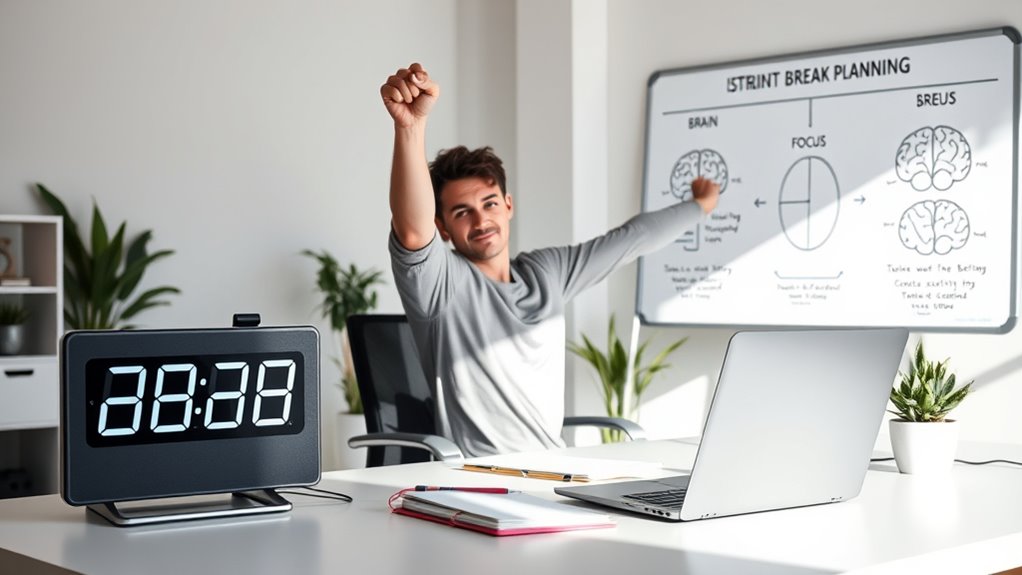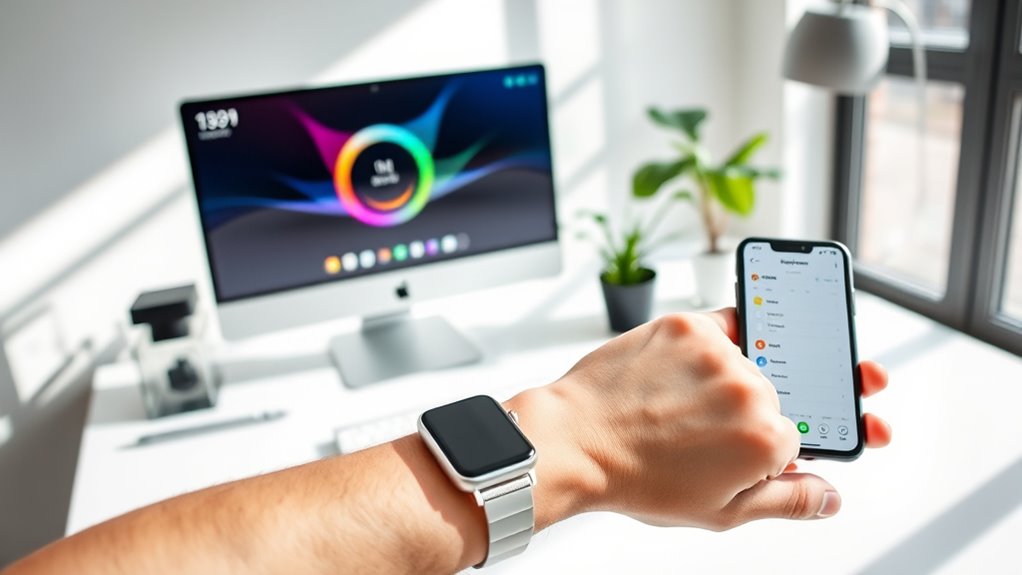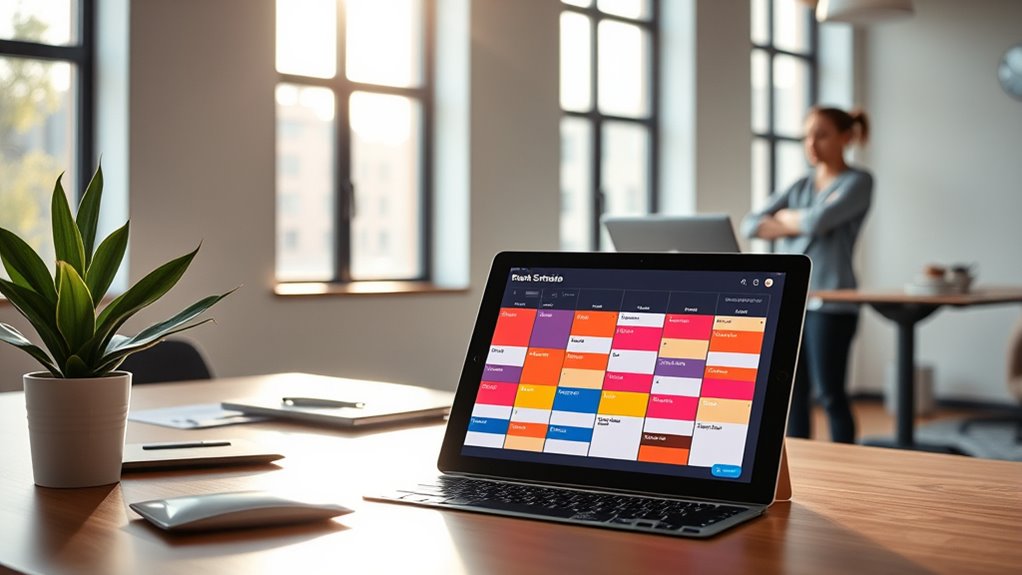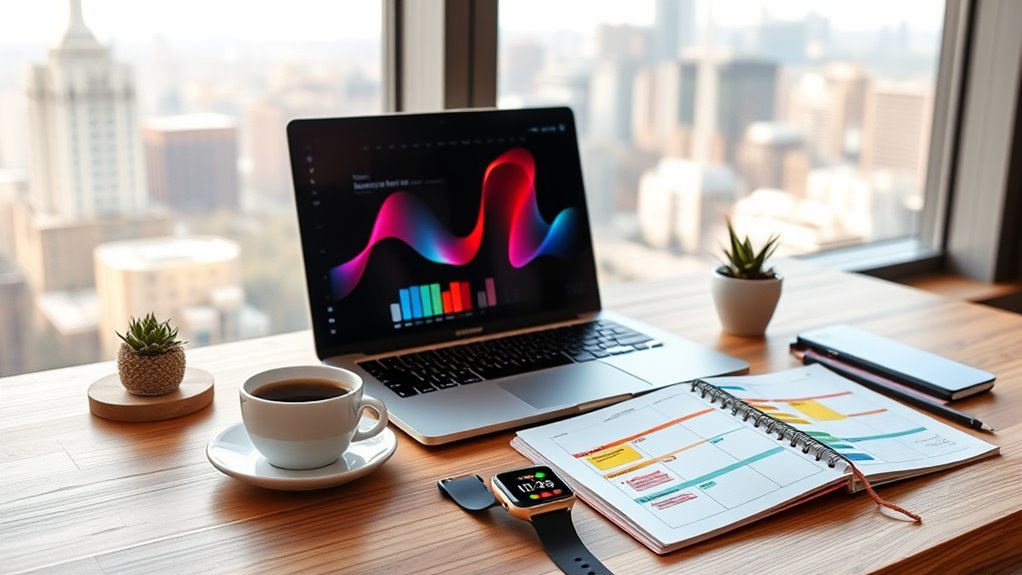To maximize productivity through smart break planning, schedule regular short breaks—about 5-10 minutes every hour—to prevent fatigue and keep your focus sharp. Use activity variety, like stretching or quick mental exercises, to refresh your mind and body. Leverage technology with reminders and track your energy levels to personalize routines that match your natural rhythms. Keep refining your approach by analyzing what works best; explore more strategies to boost your efficiency even further.
Key Takeaways
- Schedule regular, personalized breaks aligned with natural energy peaks to prevent fatigue and maintain focus.
- Incorporate diverse activities—physical, mental, and creative—to fully refresh mind and body during breaks.
- Use wearable devices and app notifications to monitor activity and prompt timely, effective breaks.
- Track productivity metrics to analyze break impact and refine strategies for maximum efficiency.
- Adapt break timing and duration based on workload, energy levels, and individual work patterns for optimal results.
Understanding the Science Behind Breaks and Focus

Have you ever wondered why taking regular breaks can actually boost your productivity? Neuroscience insights reveal that your brain isn’t designed to focus intensely for long periods. When you work nonstop, cognitive fatigue sets in, diminishing your ability to concentrate and process information effectively. Breaks help reset your brain, allowing neural pathways to recover and recharge. During rest periods, your brain consolidates memories and clears mental clutter, which enhances focus when you return to work. Understanding this science shows that breaks aren’t just leisure—they’re essential for maintaining peak cognitive performance. By listening to your brain’s signals and incorporating strategic pauses, you can prevent burnout and sustain higher productivity levels throughout your day. Additionally, sneaker culture trends demonstrate how modern consumers prioritize comfort and innovative materials, which can influence workplace attire and overall comfort during work hours.
Identifying the Optimal Break Frequency and Duration

To maximize the benefits of taking breaks, it’s important to identify the right break frequency and duration that work best for you. Start by observing how long you can work effectively before your focus dips. Many find that a break every 90 minutes helps maintain productivity, but this varies based on individual stamina. Short breaks of 5-10 minutes can prevent fatigue and keep your mind sharp. Longer breaks, around 15-30 minutes, may be necessary for sustained tasks or when feeling overwhelmed. Pay attention to your energy levels and mental clarity to fine-tune your break schedule. Remember, consistency is key—finding your ideal break frequency and duration ensures you recharge without losing momentum. Adjust as needed for maximum productivity and well-being. Incorporating personalized strategies can further optimize your break planning for better results.
Incorporating Different Types of Break Activities

To boost your productivity, try mixing different break activities like stretching or quick walks to get your body moving. Taking mental breaks with puzzles or meditation can refresh your focus, while creative tasks like doodling or brainstorming spark new ideas. Incorporating these varied activities keeps your mind sharp and energy high throughout the day. Additionally, using proper tools and equipment, such as ergonomic accessories or reliable paint sprayers, can reduce fatigue and improve efficiency during work sessions.
Physical Movement Benefits
Incorporating different types of break activities that involve physical movement can considerably boost your productivity. Moving around during breaks offers ergonomic benefits by reducing strain and preventing stiff muscles, especially if you sit for long periods. Simple activities like stretching or walking improve circulation, which can boost your energy levels and focus. These movements also promote health improvements by decreasing the risk of issues like back pain and joint discomfort. Regular physical activity during breaks helps reset your body, making it easier to maintain good posture and avoid fatigue. Additionally, engaging in light exercise can elevate endorphin levels, reducing stress and enhancing your overall well-being. Understanding climate control can help you create a more comfortable work environment that supports these healthy break activities. By intentionally including movement in your breaks, you optimize both your physical health and work efficiency.
Mental Refresh Strategies
Taking breaks that include mental refresh activities can substantially enhance your focus and overall productivity. To refresh your mind effectively, try these strategies:
- Practice mindfulness techniques like deep breathing or meditation to clear mental clutter.
- Enjoy a small, nutritious snack to boost energy without a sugar crash.
- Take a moment for visualization exercises, imagining calming scenes or positive outcomes.
- Engage in quick mental puzzles or brain teasers to stimulate your cognitive functions.
- Incorporate mindfulness practices during your breaks to foster present-moment awareness and reduce stress.
These activities help reset your mental state, reduce stress, and improve concentration. Incorporating mindfulness techniques during breaks encourages present-moment awareness, while nutritious snacks fuel your brain. By intentionally integrating these mental refresh strategies, you’ll sustain productivity and maintain mental clarity throughout your workday.
Creative Engagement Ideas
Engaging in a variety of break activities can spark your creativity and keep your energy levels high throughout the day. Incorporate brainstorming exercises during your breaks to generate fresh ideas and overcome mental blocks. Using creative prompts, like doodling, writing a quick story, or imagining new solutions, can stimulate your mind in unexpected ways. These activities encourage divergent thinking and help you return to work with a renewed perspective. Mix up your breaks with different creative tasks—try quick puzzles, mind maps, or even collaborative challenges with colleagues. The key is to choose activities that relax your mind while still engaging your creative muscles. Incorporating diverse activities into your break routine not only boosts productivity but also helps maintain a positive mindset throughout the day.
Leveraging Technology to Remind and Track Breaks

Technology offers powerful tools to help you stay on top of your breaks, ensuring you don’t overlook their importance. Wearable devices can monitor your activity levels and remind you when it’s time to rest. App notifications can send timely alerts, prompting you to step away and recharge. To make the most of these tools, consider:
- Setting customized reminders on your smartphone or tablet.
- Using wearable devices that track your movement and prompt breaks.
- Enabling notifications during your focused work sessions.
- Syncing these alerts with your calendar for seamless scheduling.
Additionally, security systems can be integrated into your workspace to monitor activity and ensure safety during breaks, further supporting your productivity.
Customizing Break Strategies for Your Work Style

To optimize your break routine, adapting strategies that align with your unique work style is essential. Personalized routines ensure you take breaks when you need them most, whether you’re a morning person or someone who hits a slump in the afternoon. By implementing adaptive scheduling, you can adjust break times based on your workload and energy levels, making each pause more effective. Consider experimenting with different lengths and timings of breaks to discover what boosts your focus and reduces fatigue. Recognizing your natural rhythms allows you to create a flexible plan that fits seamlessly into your day. Incorporating break planning strategies can further enhance your productivity and well-being. Customizing your break strategies helps you stay productive while honoring your individual work habits, leading to better results and improved well-being.
Measuring the Impact of Break Planning on Productivity

Tracking how your customized break strategies influence your productivity is key to understanding their true effectiveness. To measure break effectiveness, focus on relevant productivity metrics that reflect your work patterns.
A good approach is to analyze how GMC tuning adjustments impact your overall workflow and output.
- Track task completion rates before and after implementing breaks.
- Monitor concentration levels during work sessions.
- Record energy fluctuations throughout the day.
- Compare overall output and quality of work over time.
Using these metrics, you can identify whether your breaks boost focus and efficiency. Adjust your break timing or duration based on what the data reveals. Regularly evaluating your productivity metrics helps you fine-tune your approach, ensuring your break planning consistently enhances your overall productivity. This data-driven method allows you to maximize the benefits of smart break strategies.
Frequently Asked Questions
How Do Personal Preferences Influence Ideal Break Schedules?
Your personal preferences markedly influence your ideal break schedule because they determine when and how long you feel most refreshed. Break customization allows you to tailor your breaks to match your energy levels and work style. By paying attention to what energizes you—whether short, frequent pauses or longer, less frequent rests—you can optimize your productivity and maintain focus throughout the day. Listening to yourself helps create a break plan that works best for you.
Can Break Strategies Vary Across Different Industries or Job Roles?
Some might think one-size-fits-all break strategies work, but they don’t. Industry-specific schedules and role-based strategies matter because different jobs demand different focus levels and physical activity. You should adapt break plans to your industry or role, whether you’re in a creative field, manufacturing, or customer service. This tailored approach keeps you energized, boosts productivity, and prevents burnout, ensuring your breaks are as effective as your work.
What Are Common Pitfalls When Implementing Break Plans?
When implementing break plans, you might face pitfalls like overestimating how much time you need or struggling with time mismanagement. Overcoming resistance from colleagues or managers who see breaks as unproductive can be tough too. To succeed, communicate the benefits clearly, set realistic break schedules, and stay disciplined. Avoid ignoring your body’s signals, and regularly review your plan to guarantee it supports your productivity without causing unnecessary interruptions.
How Do Breaks Affect Mental Health and Overall Well-Being?
Imagine your mind as a garden needing gentle care; breaks refresh your mental health and boost well-being. When you take mindful pauses, you reconnect with your thoughts, reducing stress. Engaging in social interactions during breaks fosters a sense of belonging and happiness. These moments help prevent burnout, sharpen focus, and improve mood, ensuring you feel more balanced and resilient throughout your day.
Are There Long-Term Productivity Benefits From Consistent Break Routines?
Consistent break routines can lead to long-term productivity benefits by reinforcing good habit formation and improving time management. When you take regular breaks, you develop a pattern that enhances focus and reduces burnout over time. This consistency helps you manage your workload more efficiently, making it easier to stay motivated and maintain high performance. Over the long run, these routines support sustained productivity and better overall work quality.
Conclusion
By planning your breaks wisely, you can boost your focus and overall productivity. Some might think taking breaks interrupts flow, but research shows the opposite—regular breaks refresh your mind and improve performance. Don’t wait until burnout hits; start customizing your break strategy today. With simple tweaks and tech tools, you’ll find it easier to stay energized and accomplish more. So, give yourself permission to pause—you’ll thank yourself later.









